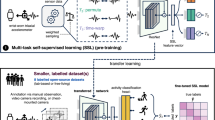Abstract
This paper proposes a new daily activity recognition method that can learn an activity classification model with small quantities of training data by sharing training data among different activity classes. Many existing activity recognition studies employ a supervised machine learning approach and thus require an end user’s labeled training data, this approach places a large burden on the user. In this study, we assume that a user wears sensors (accelerometers) on several parts of the body such as the hands, waist, and thigh, and we attempt to share sensor data obtained from only selected accelerometers (e.g., only waist and thigh sensors) among two different activity classes based on a sensor data similarity measure. This approach permits us to correctly learn parameters of an activity classification model by using sufficient quantities of shared sensor data without adding new training data. We confirmed the effectiveness of our method by using 48 h of sensor data obtained from 20 participants, and achieved a good recognition accuracy.

















Similar content being viewed by others
Explore related subjects
Discover the latest articles, news and stories from top researchers in related subjects.References
Bao L, Intille S (2004) Activity recognition from user-annotated acceleration data. In: Ferscha A, Mattern F (eds) Pervasive 2004. LNCS, vol 3001, pp 1–17
Bouchard B, Giroux S, Bouzouane A (2007) A keyhole plan recognition model for Alzheimer’s patients: first results. Appl Artif Intell 21(7):623–658
Casio Inc. Casio products. http://www.casio.com/products/Timepiece/Sports/
Dempster A, Laird N, Rubin D et al (1977) Maximum likelihood from incomplete data via the EM algorithm. J R Stat Soc Ser B (Methodological) 39(1):1–38
Forster K, Biasiucci A, Chavarriaga R, del R Millan, J, Roggen D, Tröster G (2010) On the use of brain decoded signals for online user adaptive gesture recognition systems. In: Proceedings of 8th international conference on pervasive computing, pp 427–444
Huynh T, Schiele B (2006) Towards less supervision in activity recognition from wearable sensors. In: Proceedings of international symposium on wearable computers, pp 3–10
Jenssen R, Erdogmus D, Hild K, Principe J, Eltoft T (2005) Optimizing the Cauchy-Schwarz PDF distance for information theoretic, non-parametric clustering. In: Energy minimization methods in computer vision and pattern recognition, pp 34–45
Kampa K, Hasanbelliu E, Principe J (2011) Closed-form Cauchy-Schwarz PDF divergence for mixture of Gaussians. In: Proceedings of international joint conference on neural networks, pp 2578–2585
Krassnig G, Tantinger D, Hofmann C, Wittenberg T, Struck M (2010) User-friendly system for recognition of activities with an accelerometer. In: Proceedings of 4th international conference on-no permissions, pp 1–8
Lane N, Xu Y, Lu H, Hu S, Choudhury T, Campbell A, Zhao F (2011) Enabling large-scale human activity inference on smartphones using community similarity networks (CSN). In: Proceedings of UbiComp, 17–21 Sept 2011, Beijing, China, pp 355–364
Lester J, Choudhury T, Borriello G (2006) A practical approach to recognizing physical activities. In: Pervasive, LNCS 3968, pp 1–16
Lukowicz P, Junker H, Stager M, Buren TV, Tröster G (2002) Wearnet: A distributed multi-sensor system for context aware wearables. In: Proceedings of Ubicomp 2002, pp 361–370
Maekawa T, Watanabe S (2011) Unsupervised activity recognition with user’s physical characteristics data. In: Proceedings of international symposium on wearable computers, pp 89–96
Maekawa T, Yanagisawa Y, Kishino Y, Ishiguro K, Kamei K, Sakurai Y, Okadome T (2010) Object-based activity recognition with heterogeneous sensors on wrist. In: Pervasive 2010, pp 246–264
NIKE Inc. Nike+. http://nikeplus.nike.com/plus/
Ohmura R, Hashida N, Imai M (2009) Preliminary evaluation of personal adaptation techniques in accelerometer-based activity recognition. In: Proceedings of 13th international symposium on late breaking results, wearable computers, Linz, Austria, Sept 2009
Pollack M, Brown L, Colbry D, McCarthy C, Orosz C, Peintner B, Ramakrishnan S, Tsamardinos I (2003) Autominder: an intelligent cognitive orthotic system for people with memory impairment. Robot Auton Syst 44(3):273–282
Ravi N, Dandekar N, Mysore P, Littman M (2005) Activity recognition from accelerometer data. In: IAAI 2005, vol. 20, pp 1541–1546
Stikic M, Van Laerhoven K, Schiele B (2008) Exploring semi-supervised and active learning for activity recognition. In: Proceedings of international symposium on wearable computers, pp 81–88
Welk G, Differding J (2000) The utility of the digi-walker step counter to assess daily physical activity patterns. Med Sci Sports Exerc 32(9):S481–S488
Witten I, Frank E (2004) Data mining: practical machine learning tools and techniques. Morgan Kaufmann, Burlington
Author information
Authors and Affiliations
Corresponding author
Rights and permissions
About this article
Cite this article
Kong, Q., Maekawa, T. Reusing training data with generative/discriminative hybrid model for practical acceleration-based activity recognition. Computing 96, 875–895 (2014). https://doi.org/10.1007/s00607-013-0326-0
Received:
Accepted:
Published:
Issue Date:
DOI: https://doi.org/10.1007/s00607-013-0326-0




